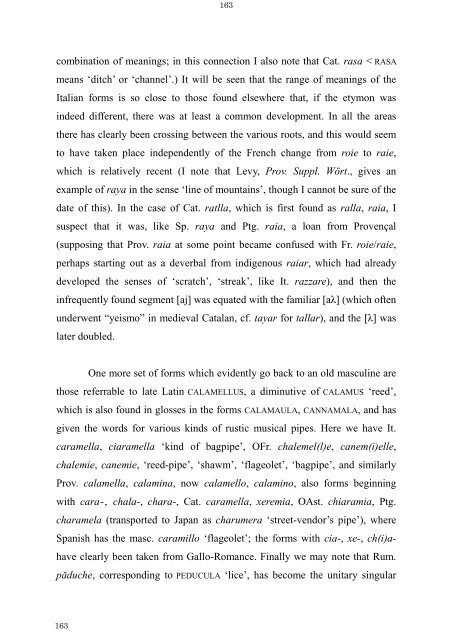The Latin Neuter Plurals in Romance - Page ON
The Latin Neuter Plurals in Romance - Page ON
The Latin Neuter Plurals in Romance - Page ON
You also want an ePaper? Increase the reach of your titles
YUMPU automatically turns print PDFs into web optimized ePapers that Google loves.
163<br />
163<br />
comb<strong>in</strong>ation of mean<strong>in</strong>gs; <strong>in</strong> this connection I also note that Cat. rasa < RASA<br />
means ‘ditch’ or ‘channel’.) It will be seen that the range of mean<strong>in</strong>gs of the<br />
Italian forms is so close to those found elsewhere that, if the etymon was<br />
<strong>in</strong>deed different, there was at least a common development. In all the areas<br />
there has clearly been cross<strong>in</strong>g between the various roots, and this would seem<br />
to have taken place <strong>in</strong>dependently of the French change from roie to raie,<br />
which is relatively recent (I note that Levy, Prov. Suppl. Wört., gives an<br />
example of raya <strong>in</strong> the sense ‘l<strong>in</strong>e of mounta<strong>in</strong>s’, though I cannot be sure of the<br />
date of this). In the case of Cat. ratlla, which is first found as ralla, raia, I<br />
suspect that it was, like Sp. raya and Ptg. raia, a loan from Provençal<br />
(suppos<strong>in</strong>g that Prov. raia at some po<strong>in</strong>t became confused with Fr. roie/raie,<br />
perhaps start<strong>in</strong>g out as a deverbal from <strong>in</strong>digenous raiar, which had already<br />
developed the senses of ‘scratch’, ‘streak’, like It. razzare), and then the<br />
<strong>in</strong>frequently found segment [aj] was equated with the familiar [aλ] (which often<br />
underwent “yeismo” <strong>in</strong> medieval Catalan, cf. tayar for tallar), and the [λ] was<br />
later doubled.<br />
One more set of forms which evidently go back to an old mascul<strong>in</strong>e are<br />
those referrable to late <strong>Lat<strong>in</strong></strong> CALAMELLUS, a dim<strong>in</strong>utive of CALAMUS ‘reed’,<br />
which is also found <strong>in</strong> glosses <strong>in</strong> the forms CALAMAULA, CANNAMALA, and has<br />
given the words for various k<strong>in</strong>ds of rustic musical pipes. Here we have It.<br />
caramella, ciaramella ‘k<strong>in</strong>d of bagpipe’, OFr. chalemel(l)e, canem(i)elle,<br />
chalemie, canemie, ‘reed-pipe’, ‘shawm’, ‘flageolet’, ‘bagpipe’, and similarly<br />
Prov. calamella, calam<strong>in</strong>a, now calamello, calam<strong>in</strong>o, also forms beg<strong>in</strong>n<strong>in</strong>g<br />
with cara-, chala-, chara-, Cat. caramella, xeremia, OAst. chiaramia, Ptg.<br />
charamela (transported to Japan as charumera ‘street-vendor’s pipe’), where<br />
Spanish has the masc. caramillo ‘flageolet’; the forms with cia-, xe-, ch(i)a-<br />
have clearly been taken from Gallo-<strong>Romance</strong>. F<strong>in</strong>ally we may note that Rum.<br />
păduche, correspond<strong>in</strong>g to PEDUCULA ‘lice’, has become the unitary s<strong>in</strong>gular









